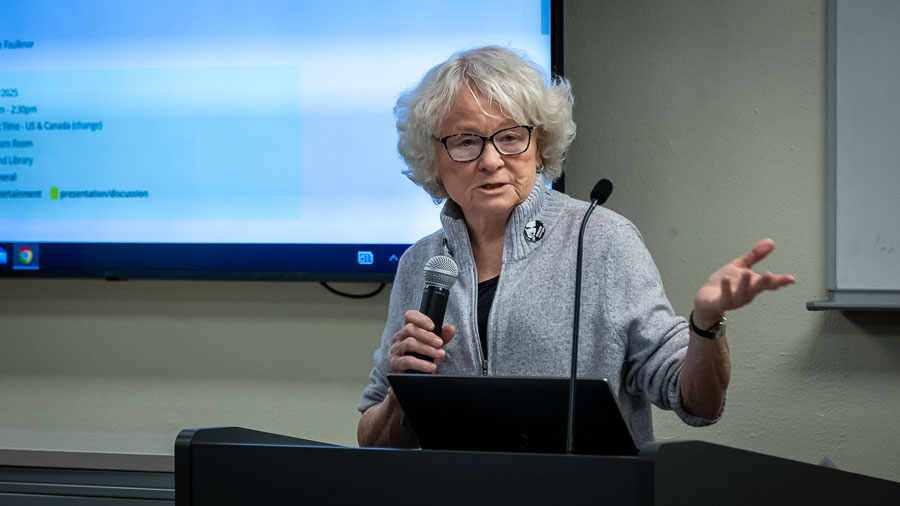‘Pretty incredible’: As Redmond grows, water use per resident actually goes down
Published 5:45 am Tuesday, October 15, 2024

- Diana Hardin, 82, showing her drip irrigation timer. The system waters her plants and flowers for 10 minutes per day in the summer months. She adjusts it every three days or so.
With a steadily-growing population and a steadily-drying climate, Redmond residents — and the city itself — are working to make sure there is stable supply of water on hand for current and future citizens.
Water use by and in the city has decreased since 2021, despite roughly 3,000 new residents moving to Redmond since that time. The reduction in usage is due, in part, by city programs to reduce residential water use in outdoor areas like lawns and gardens.
“That is pretty incredible,” said Josh Wedding, the city of Redmond’s public works operations manager.
In the 2017-18 fiscal year, the average Redmond home used 221.6 gallons of water a day. By 2023-2024, that number decreased by 22 percent to 173 gallons per day.
In 2021, the entire city of Redmond used 2.54 billion gallons. Two years later, the city had reduced that by 4 percent to 2.43 billion gallons.
The reduction — both on the micro and macro level — is in part due to a reduction in open, sometimes irrigated land in the city and denser housing with smaller lawns and yards. But it’s also due to stronger messaging, higher water prices and a city that is working to save a few drops where it can.
“With residential customers making up the lion’s share of our accounts here in town, that is where we are focusing on becoming more efficient in regard to water use,” said Wedding said. He noted that residents use 69% of the city’s overall water. Commercial demand is around 17-18%.
“This July was a great opportunity for us to see how our conservation message was doing,” said Wedding. “We experienced one of the hottest July’s ever, served a population greater than it was last July and still produced less water.”
Redmond used 4 million fewer gallons of water in July 2024 than it did in 2023, according to Wedding.
“For us, this is quite an accomplishment,” he said.
A denser city is more efficient
In a study conducted by Redmond Public Works, a denser city means less water is used per person. If Redmond’s population keeps rising, more people will inhabit every acre. That increase the demand of water in that area, but each individual water user may require less.
“If it is multi-family, high density housing, you’re going to cram more people in there than you would if it was a 10,000-square-foot lot with outdoor irrigation,” Wedding said.
Even though work is being done to bring down water levels on a per-person basis, overall water consumption is still one of the city’s highest priorities. Requests to the state to drill another municipal well have recently rebuffed by the Oregon Department of Water Resources. Despite the disagreement, Gov. Tina Kotek said she thought the basin was right to take the issue seriously.
“We should be worried about (water),” Gov. Kotek said in an EO Media group interview. “In Central Oregon, it’s fast growing, but you’re also really fortunate that you have a very active group that manages the whole Deschutes River Basin. I think it’s a concern but if we start now and think about the future differently, I think it’s gonna help us in the long term.”
Local incentives
In the last few years, the city of Redmond initiated an outdoor irrigation rebate program, which encourages citizens to use water-conserving sprinklers, systems and sensors at a discounted cost. Those “smart” systems can adjust watering based on local weather and soil conditions and can use soil sensors to turn off or reduce irrigation when moisture near the root zones of plants is sufficient.
The rebate program started in 2019 with seven participants. So far in 2024, 15 more participants joined — more than previous years. In the last five years, a total of 53 participants have taken the city up on the idea, according to Maria Ramirez, special projects and natural resource program manager for the city.
More information on the outdoor irrigation rebate program can be found on their website.
The city also supplies free watering gauges, water-efficient shower heads, faucet aerators, shower timers and toilet tank displacement bags for more efficient water use.
The city has also started deliver a monthly water to citizens as part of their monthly water bill. That report their water consumption compared to the same month last year.
“On that report, we’ve included a target of ‘Here’s what you used last year, here’s what you’re using this year and here’s what it would look like if you were able to reduce your water consumption by 10%,’” Ramirez said.
According to Redmond Public Works, if the total water use decreases by 10 percent during the hottest months of the year, around 300 million gallons of water could be conserved.
The city has also charged more for its water The cost per gallon has increased 4.5% since the 2020-2021 fiscal year. That rate increases for heavy users.
The department also pushed for a watering schedule for the irrigation season that runs from April 1 to Oct. 31. It allows residents with even-numbered addresses to water on even days and odd-numbered property addresses water on odd days. Watering is not allowed on the 31st of any month and watering is not allowed between 11 a.m. and 4 p.m. to avoid waste that occurs through evaporation.
The city also encouraged residents to use AquaHawk, an online water monitor, that documents a person’s water consumption and alerts them to leaks.
What its like for lawn and garden lovers
Diana Hardin is a master gardener and has been president of the Redmond Garden Club for the last two years. At 82 years old, she spends her days admiring her own garden and spreading water-saving gardening techniques to others.
She lived in Clackamas County before moving to Redmond and caught the gardening bug there.
“It’s like the bread basket of Oregon,” she said. “You throw a seed out, it grows into a farm. That’s all you have to do, so coming here is like moving to Mars.”
Before Hardin and her husband moved into The Greens at Redmond neighborhood, their back and front yards “had nothing but grass,” Hardin said. She got to work, planting sunflowers, cherry trees, cat mint, yarrow, comb flowers, pumpkins and some drought resistant plants that can be watered less.
Hardin added a drip irrigation system that allows her to precisely monitor how often and how much water she gives her plants. She said that allows her to not only use water more efficiently, but spend less time on it.
“You can go off and leave it,” she said. “Otherwise, you’re kind of tied to your garden.”
For the last six years, Hardin has put in more drip lines as she adds more plants periodically. She runs it only about 10 minutes per day.
Through the work at her club and “for anyone who stops by” to see her garden, Hardin spreads awareness about water-wise gardening.
“I’ve helped some people in the neighborhood and given a few talks to Redmond Garden Club about converting sprinkler heads,” Hardin said. “I’ve done pubic speaking about using water-wise plants in your landscape so they don’t require a huge amount of water that will survive our (hot) days and (cold) nights.”
The Redmond Garden Club has 64 members — double what it had just two years ago.
City reductions
It isn’t just private citizens who are cutting back on water. The city’s parks and municipal facilities have reduced water use by 30% by installing smart irrigation systems, routinely having audits and maintenance checks and upgraded infrastructure.
The largest water user in Redmond is currently the Redmond School District. In 2020 to 2021 school year, before the city’s initial push to conserve water, the school district used 142 million gallons of water.
Schools have worked since then reduce their water consumption, said Logan McGinnis, public information officer for the Redmond School District.
According to Marc Horner, Redmond School District director of facilities, crews have installed water bottle refill stations, water-reducing sprinklers and zero flush toilets in schools. He said that has helped the district reduce their usage by 8 million gallons since 2021.
In the 2023-2024 school year, the school district used 134 million gallons, according to school district water data.
Despite using less water, “our water bill has increased a lot,” Horner said, due to the city raising rates. The district paid $315,700 during the 2023-2024 year, compared to the 2020-2021 bill of $279,864.
McGinnis said there is now a financial and environment push to reduce water use.
“We are trying to reduce our water and then put the money we save back into our classrooms,” he said.
As part of the bond proposal on Redmond ballots this year, schools want to start xeriscaping some of the grassy areas “across the district,” McGinnis said, adding project specifics are still in the works.
“We can’t really conserve water unless the bond passes,” said Kiara Orrison, the school district’s operations administrations assistant. “The amount of money we spend on water is crazy … so by saving water, we save money.”
Additionally, the city is converting four city-owned landscaped areas to water-wise areas this fall. The efforts will reduce natural grass and feature plants that require minimal water, said Wedding.
Where does Redmond’s water come from?
Redmond relies on groundwater from eight wells. Those wells pump groundwater from the Deschutes Formation, a large geologic formation that stretches across the Deschutes Basin. The same groundwater sources supply water to Redmond, Bend and other Central Oregon cities. It is water replenished by snow and rain that falls over the Cascade Mountains, though amid drought the depth of the groundwater reserve is declining.
The city also has six reservoirs that together can hold up to 15.5 million gallons of water.










